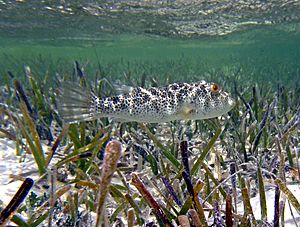Checkered puffer facts for kids
Quick facts for kids Checkered puffer |
|
|---|---|
 |
|
| Conservation status | |
| Scientific classification |
The checkered puffer (Sphoeroides testudineus) is a cool fish from the pufferfish family. They get their name because they can puff up like a balloon!
- They usually grow to be about 4 to 7 inches (10 to 18 cm) long.
- You can find them swimming in waters from 3 to 35 feet (1 to 12 meters) deep.
- They live in places like the Caribbean, The Bahamas, Florida, and the Gulf of Mexico.
Contents
What Does the Checkered Puffer Look Like?
The checkered puffer is part of a fish family called Tetraodontidae. This name means "four teeth." These puffers have four strong tooth plates, two on top and two on the bottom. They look like a powerful beak! This beak helps them crack open hard shells of prey, like snails and crabs.
Puffers are famous for their amazing ability to swell up. When they feel scared or threatened, they quickly swallow water or air. This makes them puff up like a big, spiky ball! This trick makes them look much bigger and harder for predators to eat.
Checkered puffers have smooth skin, not many scales, and small, sandpaper-like bumps. You can tell them apart from other puffers by their unique colors and patterns. They are usually light tan or yellowish. They have a cool pattern of dark gray or olive lines that look like a net or squares. In the middle of their back, they have a "bulls-eye" pattern. You might also see small, dark brown spots on their cheeks and lower sides. Their belly is white and plain. Their tail fin has dark bands.
Where Do Checkered Puffers Live?
The checkered puffer lives in warm waters along the coast. You can find them from Rhode Island all the way down to Florida, around Bermuda, and even in the southeastern Gulf of Mexico and Brazil.
They love to hang out in bays, areas with lots of seagrass, and places where the water flows in and out with the tides. They also live near mangrove trees and can even be found in some freshwater areas. In places like the Indian River Lagoon in Florida, they are common in seagrass beds and around mangrove roots. Sometimes, they are also seen in rocky areas.
Life of a Checkered Puffer
Scientists don't know exactly how long checkered puffers live. Their growth depends on things like how much food they can find and the conditions of their environment. While some have been reported to reach up to 12 inches (30 cm), most checkered puffers are much smaller.
Even though we don't have exact numbers, checkered puffers are a common fish in many coastal areas. Young puffers are often found hiding in seagrass beds and among the roots of mangrove trees. In some places, like the coastal waters of Yucatán, Mexico, the checkered puffer is one of the most common fish species!
See also
 In Spanish: Sphoeroides testudineus para niños
In Spanish: Sphoeroides testudineus para niños


